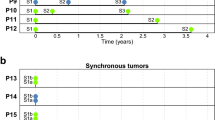Abstract
The genetic change that leads to the activation of the oncogene in T24 human bladder carcinoma cells is shown to be a single point mutation of guanosine into thymidine. This substitution results in the incorporation of valine instead of glycine as the twelfth amino acid residue of the T24 oncogene-encoded p21 protein. Thus, a single amino acid substitution appears to be sufficient to confer transforming properties on the gene product of the T24 human bladder carcinoma oncogene.
Similar content being viewed by others
References
Cooper, G. M. Science 217, 801–806 (1982).
Krontiris, T. G. & Cooper, G. M. Proc. natn. Acad. Sci. U.S.A. 78, 1181–1184 (1981).
Shih, C., Padhy, C., Murray, M. & Weinberg, R. A. Nature 290, 261–264 (1981).
Lane, M. A., Sainten, A. & Cooper, G. M. Proc. natn. Acad. Sci. U.S.A. 78, 5185–5189 (1981).
Murray, M. J. et al. Cell 25, 355–361 (1981).
Perucho, M. et al. Cell 27, 467–476 (1981).
Lane, M. A., Sainten, A. & Cooper, G. M. Cell 28, 873–880 (1982).
Pulciani, S. et al. Proc. natn. Acad. Sci. U.S.A. 79, 2845–2849 (1982).
Goldfarb, M., Shimizu, K., Perucho, M. & Wigler, M. Nature 296, 404–409 (1982).
Shih, C. & Weinberg, R. A. Cell 29, 161–169 (1982).
Santos, E., Tronick, S. R., Aaronson, S. A., Pulciani, S. & Barbacid, M. Nature 298, 343–347 (1982).
Der, C. J., Krontiris, T. G. & Cooper, G. M. Proc. natn. Acad. Sci. U.S.A. 79, 3637–3640 (1982).
Parada, L. F., Tabin, C. J., Shih, C. & Weinberg, R. A. Nature 297, 474–478 (1982).
Chang, E. H., Gonda, M. A., Ellis, R. W., Scolnick, E. M. & Lowy, D. R. Proc. natn. Acad. Sci. U.S.A. 79, 4848–4852 (1982).
Dhar, R. et al. Science 217, 934–937 (1982).
Reddy et al. (in preparation).
Sharp, P. A. Cell 23, 643–646 (1981).
Tsuchida, N., Ryder, T. & Ohtsubo, E. Science 217, 937–939 (1982).
Pulciani, S., Santos, E., Lauver, A. V., Long, L. K. & Barbacid, M. Nature (in the press).
Garnier, J., Osguthorpe, D. J. & Robson, B. J. molec. Biol. 120, 97–120 (1978).
Shih, T. Y. et al. J. Virol. 42, 253–261 (1982).
Chang, E. H., Furth, M. E., Scolnick, E. M. & Lowy, D. R. Nature 297, 479–483 (1982).
Maxam, A. M. & Gilbert, W. Proc. natn. Acad. Sci. U.S.A. 74, 560–564 (1977).
Author information
Authors and Affiliations
Rights and permissions
About this article
Cite this article
Reddy, E., Reynolds, R., Santos, E. et al. A point mutation is responsible for the acquisition of transforming properties by the T24 human bladder carcinoma oncogene. Nature 300, 149–152 (1982). https://doi.org/10.1038/300149a0
Received:
Accepted:
Issue Date:
DOI: https://doi.org/10.1038/300149a0
- Springer Nature Limited
This article is cited by
-
The path to the clinic: a comprehensive review on direct KRASG12C inhibitors
Journal of Experimental & Clinical Cancer Research (2022)
-
Targeting farnesylation as a novel therapeutic approach in HRAS-mutant rhabdomyosarcoma
Oncogene (2022)
-
Pharmacogenomics, biomarker network, and allele frequencies in colorectal cancer
The Pharmacogenomics Journal (2020)
-
The impact of oncogenic RAS on redox balance and implications for cancer development
Cell Death & Disease (2019)





